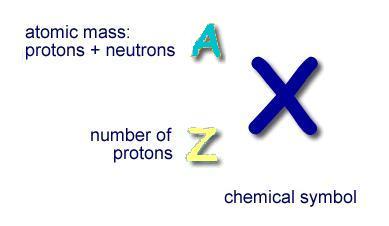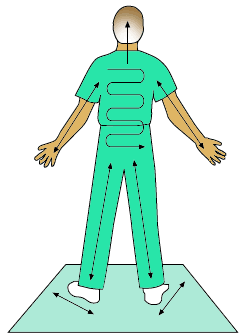Radiation Basics
top of page
Differences Between Radiation Contamination and Exposure
top of page
Atomic Number and Atomic Mass
|
- The illustration below shows the chemical symbol for the hypothetical element "X"
- The number of protons in the nucleus is represented by "Z", the atomic number
- All the isotopes of an element have the same "Z"
- The atomic mass of the element (number of protons plus the number neutrons) is represented by "A"
- "A" is usually placed to the left above the element symbol
- The number of neutrons in the nucleus is equal to A minus Z
|
| |

|
|
- Two different forms, or isotopes, of carbon are shown below:
- Carbon-12: with 6 protons and 6 neutrons and an atomic mass of 12
- Carbon-14: with 6 protons and 8 neutrons and an atomic mass of 14
|
|
|
| |
Adapted from Atomic Shorthand (EPA) |
| |
top of page |
Understanding Effects of Relative Doses of Radiation
|
| |
|
top of page |
Radioactive Properties, Internal Distribution, and Risk Coefficients
|
|
|
| |
top of page |
Isotopes of Interest: Properties, Treatment, and Fact Sheets
Information in this table adapted from:
Isotope |
Ionizing radiation
decay mode |
Radioactive half-life |
Major exposure pathways |
Focal accumulation |
Treatment:
References for use |
Fact sheets
(CDC,
ATSDR,
EPA,
Argonne Natl. Lab, Wikipedia) |
Americium
(Am-241) |
α |
458 years |
Inhalation
Skin |
Lungs
Liver
Bone
Bone marrow
|
DTPA† * |
CDC
ATSDR
EPA
Argonne (PDF - 2.34 MB)
Wikipedia
|
Californium
(Cf-252) |
α, γ |
2.6 years |
Inhalation
Ingestion |
Bone
Liver |
DTPA* |
Argonne (PDF - 2.34 MB)
Wikipedia
|
Cesium
(Cs-137) |
β, γ |
30 years |
Inhalation
Ingestion |
Follows potassium; renal excretion |
Prussian blue, insoluble† * |
CDC
ATSDR
EPA
Argonne (PDF - 2.34 MB)
Wikipedia
|
| Cobalt
(Co-60) |
β, γ |
5.26 years |
Inhalation |
Liver |
Succimer (DMSA)§ (DailyMed)
DTPA*
EDTA§
N-Acetyl-L-cysteine§ |
CDC
ATSDR
EPA
Argonne (PDF - 2.34 MB)
Wikipedia
|
Curium
(Cm-244) |
α, γ, neutron |
18 years |
Inhalation
Ingestion |
Liver
Bone |
DTPA† * |
Argonne (PDF - 2.34 MB)
Wikipedia
|
| Iodine
(I-131) |
β, γ |
8.1 days |
Inhalation
Ingestion
Skin |
Thyroid |
Potassium iodide† *
Saturated solution of potassium iodide§
Propylthiouracil§
Methimazole§
Potassium iodate§ |
CDC
ATSDR
EPA
Argonne (PDF - 2.34 MB)
Wikipedia
|
Iridium
(Ir-192) |
β, γ |
74 days |
N/A |
Spleen |
Consider DTPA*
Consider EDTA§ |
CDC
Argonne (PDF - 2.34 MB)
Wikipedia
|
Isotope |
Ionizing radiation
decay mode |
Radioactive half-life |
Major exposure pathways |
Focal accumulation |
Treatment:
References for use |
Fact sheets
(CDC,
ATSDR,
EPA,
Argonne Natl. Lab, Wikipedia) |
Phosphorus
(P-32) |
β |
14.3 days |
Inhalation
Ingestion
Skin |
Bone
Bone marrow
Rapidly replicating cells |
Hydration + Phosphate drugs
|
Wikipedia |
| Plutonium
(Pu-239) |
α |
24,100 years |
Inhalation (limited absorption) |
Lung
Bone
Bone marrow
Liver
Gonads |
DTPA§
DFOA§
EDTA§
DTPA + DFOA§
|
CDC
ATSDR
EPA
Argonne (PDF - 2.34 MB)
Wikipedia
IEER
|
Polonium
(Po-210) |
α |
138.4 days |
Inhalation
Ingestion
Skin |
Spleen
Kidneys
Lymph nodes
Bone marrow
Liver
Lung mucosa |
Gastric Lavage
Dimercaprol (BAL)*
Succimer (DMSA)§ (DailyMed)
D-Penicillamine§ (DailyMed)
|
CDC
Argonne (PDF - 2.34 MB)
HPS (PDF - 492 KB)
NRC
Wikipedia
More references
|
| Radium
(Ra-226) |
α, β, γ |
1,602 years |
Ingestion |
Bone |
Aluminum hydroxide*
Barium sulfate*
Sodium alginate§
Calcium phosphate§
|
ATSDR
EPA
Argonne (PDF - 2.34 MB)
Wikipedia
|
| Strontium
(Sr-90) |
β |
28 years |
Inhalation
Ingestion |
Bone |
Inhalation:
Calcium gluconate§
Barium sulfate§
Ingestion:
Rx is the same as for radium (see above). Additional Rx may include stable strontium compounds:
Strontium lactate§
Strontium gluconate§
|
CDC
ATSDR
EPA
Argonne (PDF - 2.34 MB)
Wikipedia
|
Isotope |
Ionizing radiation
decay mode |
Radioactive half-life |
Major exposure pathways |
Focal accumulation |
Treatment:
References for use |
Fact sheets
(CDC,
ATSDR,
EPA,
Argonne Natl. Lab, Wikipedia) |
Thorium
(Th-232) |
α |
1.41 x 1010 years |
Inhalation
Ingestion |
Bone |
Consider DTPA* |
ATSDR
EPA
Argonne (PDF - 2.34 MB)
Wikipedia
|
| Tritium
(H-3) |
β |
12.5 years |
Inhalation
Ingestion
Skin |
Whole body |
Water diuresis* |
EPA
Public Health England (PHE), formerly Health Protection Agency (HPA), (UK)
Wikipedia
|
| Uranium
(U-235) |
α |
7.1 x 108 years |
Inhalation
Ingestion |
Kidneys
Bone |
Sodium bicarbonate*
For high level intake consider off-label diuretics and/or dialysis§ |
CDC
ATSDR
EPA
Argonne (PDF - 2.34 MB)
Wikipedia
|
| Yttrium
(Y-90)¶ |
β |
64 hours |
Inhalation
Ingestion |
Bone |
DTPA*
EDTA§ |
Argonne ¶ (PDF - 2.34 MB)
Wikipedia
|
 |
References for use
† FDA approved: Countermeasures so marked have been approved as treatment for internal contamination with the listed radioisotope by the US Food and Drug Administration (FDA).
* NCRP preferred: Countermeasures so marked have been listed as preferred treatments for internal contamination with the listed radioisotope by the National Council on Radiation Protection and Measurements [Management of Persons Contaminated with Radionuclides: Handbook (NCRP Report No. 161, Vol. I)]. Except where noted, use of these countermeasures has not been approved by the US Food and Drug Administration (FDA).
§ NCRP suggested: Countermeasures so marked have been listed as suggested treatments for internal contamination with the listed radioisotope by the National Council on Radiation Protection and Measurements [Management of Persons Contaminated with Radionuclides: Handbook (NCRP Report No. 161, Vol. I)]. Use of these countermeasures has not been approved by the US Food and Drug Administration (FDA).
See also:
More Polonium-210 references
¶ For Yttrium-90 radioactive properties and health concerns, see Strontium-90 Human Health Fact Sheet
|
| |
| top of page |
Categorization of Radioisotopes by Regulating Agencies
top of page
Radiation Units of Measure
| Unit | Abbreviation | Definition | Comment |
|---|
| Roentgen |
R |
The amount of energy absorbed in air |
For x-rays and gamma rays only |
| Radiation absorbed dose |
rad |
The energy absorbed per gram of material
1 rad = 100 ergs/gram |
Important because it represents the amount of energy that is absorbed by the material of interest-e.g., person, organ, tissue, cells |
| Roentgen equivalent man |
Rem |
The product of the amount of energy absorbed (rad) times the efficiency of radiation in producing damage
rem = rad x (Wr) |
Accounts for the different degrees of damage produced by equal doses of different radiations, for example:
Radiation
Radiation Weighting Factor (Wr)
x rays
gamma rays
beta particles
1
neutrons
range 2-20
alpha particle
20
|
| Gray* |
Gy |
1 Gy = 100 rad |
1 Gy = 1 joule/kilogram |
| Sievert* |
Sv |
1 Sv = 1 Gy x Wr |
1 Sv = 100 rem |
| Curie |
Ci |
The number of radioactive decays (disintegrations)/ unit of time |
1 Ci = 2.2 x 1012 disintegrations/minute
1 Ci = 3.7 x 1010 disintegrations/second
|
| Becquerel* |
Bq |
The number of radioactive decays (disintegrations)/ unit of time |
1 Bq = 60 disintegrations/minute
1 Bq = 1 disintegration/second
|
* International units (SI) of Bequerel, Gray and Sievert are the currently favored expressions.
Adapted from:
Program on Technology Innovation: Evaluation of Updated Research on the Health Effects and Risks Associated with Low Dose Radiation (PDF - 903 KB) (Electric Power Research Institute [EPRI] document 1019227, Table 2-1, page 42, November 2009)
See also:
top of page
Radiation Units and Conversions
Radiation Units and Conversions: Details
- Define units of measure
- Interactive tools for unit conversions
- Prefixes and superscripts
top of page
How to do a Survey for Radiation Contamination
 |
|
 
- Survey with Geiger-Mueller Detector
- Probe held about 1/2 inch from surface
- Move at a rate of 1 to 2 inches per second
- Follow a systematic pattern (see below)
- Document readings in counts per minute (CPM) on a body chart (PDF - 49 KB)
- Compare radiation survey results before and after decontamination procedure
- Use nuclear medicine and radiation therapy technologists or others familiar with the use of radiation detection instruments
- Goal is < 2 times background radiation reading
- In general, areas that register more than twice the previously determined background radiation level are considered contaminated.
- For accidents involving alpha particle emitters, if the reading is less than twice the background radiation level, the person is not contaminated to a medically significant degree. If the accident circumstances indicate that an alpha particle emitter (such as plutonium) or low-energy beta emitter could be a contaminant, a health physicist should always be consulted.
- Specifics of the survey
- Have the person stand on a clean pad.
- Instruct the person to stand straight, feet spread slightly, arms extended with palms up and fingers straight out.
- Monitor both hands and arms; then repeat with hands and arms turned over.
- Starting at the top of the head, cover the entire body, monitoring carefully the forehead, nose, mouth, neckline, torso, knees, and ankles.
- Have the person turn around; repeat the survey on the back of the body.
- Monitor the soles of the feet.
|
Adapted from How to Detect Radiation (Radiation Emergency Assistance Center/Training Site (REAC/TS))
See also: Video: Screening People for External Contamination: How to Use Hand-held Radiation Survey Equipment (HHS/CDC) 
|
|
top of page
|
Annual Limits of Intake (ALIs) for Radioactive Isotopes in the Workplace
|
Radioisotope |
Chemical Form |
Retention Time |
Ingestion ALI (μCi) |
Inhalation ALI (μCi) |
Americium-241 |
All compounds |
Weeks |
8 x 10-1 |
6 x 10-3 |
Cesium-137 |
All
compounds |
Days |
1 x 102 |
2 x 102 |
Cobalt-60 |
All compounds, except |
Weeks
|
5 x 102
|
2 x 102
|
oxides,
hydroxides,
halides,
nitrates |
Years |
2 x 102 |
3 x 101 |
Iodine-125 |
All compounds |
Days |
4 x 101 |
6 x 101 |
Iodine-131 |
All compounds |
Days |
3 x 101 |
5 x 101 |
Iridium-192 |
All compounds, except |
Days
|
9 x 102 |
3 x 102 |
halides,
nitrates,
metallic iridium |
Weeks |
...
|
4 x 102 |
oxides,
hydroxides |
Years |
...
|
2 x 102 |
Palladium-103 |
All compounds, except |
Days |
6 x 103 |
6 x 103 |
nitrates |
Weeks |
...
|
4 x 103 |
oxides,
hydroxides |
Years |
... |
4 x 103 |
Phosphorus-32 |
All compounds, except |
Days
|
6 x 102 |
9 x 102 |
phosphates of Zn2+,
S3+,
Mg2+,
Fe3+,
Bi3+;
lanthanides |
Weeks |
...
|
4 x 102 |
Plutonium-239 |
All compounds, except |
Weeks
|
8 x 10-1 |
6 x 10-3 |
PuO2 |
Years |
...
|
2 x 10-2 |
Radium-226 |
All compounds |
Weeks
|
2 x 100 |
6 x 10-1 |
Strontium-90 |
All soluble compounds except
SrTiO3 |
Days
|
3 x 101 |
2 x 101 |
All insoluble
compounds and
SrTiO3 |
Years |
...
|
4 x 100 |
Tritium
(Hydrogen-3) |
Water |
|
8 x 104 |
8 x 104 |
Uranium-233 |
UF6, UO2F2, UO2(NO3)2 |
Days
|
1 x 101 |
1 x 100 |
UO3, UF4, UCI4 |
Weeks |
...
|
7 x 10-1 |
UO2, U3O8 |
Years |
...
|
4 x 10-2 |
Uranium-234 |
UF6, UO2F2, UO2(NO3)2 |
Days
|
1 x 101 |
1 x 100 |
UO3, UF4, UCI4 |
Weeks |
...
|
7 x 10-1 |
UO2, U3O8 |
Years
|
... |
4 x 10-2 |
Uranium-235 |
UF6, UO2F2, UO2(NO3)2 |
Days
|
1 x 101 |
1 x 100 |
UO3, UF4, UCI4 |
Weeks |
...
|
8 x 10-1 |
UO2, U3O8 |
Years
|
... |
4 x 10-2 |
Yttrium-90 |
All compounds, except |
Weeks
|
4 x 102 |
7 x 102 |
oxides,
hydroxides |
Years |
...
|
6 x 102 |
1 Adapted from Annual Limits on Intake (ALIs) and Derived Air Concentrations (DACs) of Radionuclides for Occupational Exposure (Appendix B to 10 CFR Part 20, Nuclear Regulatory Commission)
According to the introduction to Appendix B of the reference above, "The ALIs and DACs for inhalation are given for an aerosol with an activity median aerodynamic diameter (AMAD) of 1 μm and for three classes (D,W,Y) of radioactive material, which refer to their retention (approximately days, weeks or years) in the pulmonary region of the lung."
For soluble mixtures of U-234, U-235 (and U-238) in air, chemical toxicity may be the limiting factor.
NRC Listing of ALIs by Isotope (NRC)
NCRP has published new, detailed guidance on Management of Persons Contaminated With Radionuclides: Handbook3 (NCRP Report No. 161, Volume I, Bethesda, MD, 2008). It recommends a new operational quantity, "Clinical Decision Guide" (CDG), as a replacement for ALI. CDG is designed "to provide a measure that physicians can use when considering the need for medical treatment for internally-deposited radionuclides or as a screening tool...". The new guidance updates NCRP Report No. 65: Management of Persons Accidentally Contaminated with Radionuclides (National Council on Radiation Protection and Measurements, Bethesda, MD, 1980)
|
| |
top of page |
Biological Effects |
- Tapio S, Little MP, Kaiser JC, Impens N, Hamada N, Georgakilas AG, Simar D, Salomaa S. Ionizing radiation-induced circulatory and metabolic diseases. Environ Int. 2021 Jan;146:106235. [PubMed Citation]
- Kim JH, Jenrow KA, Brown SL. Mechanisms of radiation-induced normal tissue toxicity and implications for future clinical trials. Radiat Oncol J. 2014 Sep;32(3):103-15. [PubMed Citation]
- Videos
- Radiation Epidemiology for Public Health Decision Making (course available until December 23, 2021, with continuing education credits)
- Linear No-threshold (LNT) Model for Radiation Effects
- Blue Book: EPA Radiogenic Cancer Risk Models and Projections for the U.S. Population (EPA)
- Radiation Health Effects (Chronic exposure, Acute effects, Exposure Pathways, Sensitive populations (EPA)
- Effects in Children
- Scientific Finding on Effects of Radiation Exposure of Children, (PDF - 4.4 MB) (UNSCEAR 2013 Report, Volume II, Scientific Annex B. See Part VI: Health Effects)
- Grant EJ, Furukawa K, Sakata R, Sugiyama H, Sadakane A, Takahashi I, Utada M, Shimizu Y, Ozasa K. Risk of death among children of atomic bomb survivors after 62 years of follow-up: a cohort study. Lancet Oncol. 2015 Oct;16(13):1316-23. [PubMed Citation]
- Signorello LB, Mulvihill JJ, Green DM, Munro HM, Stovall M, Weathers RE, Mertens AC, Whitton JA, Robison LL, Boice JD Jr. Congenital anomalies in the children of cancer survivors: a report from the childhood cancer survivor study. J Clin Oncol. 2012 Jan 20;30(3):239-45. [PubMed Citation]
- See also: Estimates of Cancer Following Radiation Exposure
|
|
top of page |
Allowable Limits of Radiation for the General Public and Radiation Workers
Exposure Limits
|
Intended to Protect |
Nuclear Regulatory
Commission
(NRC)
|
Occupational
Safety and Health Administration
(OSHA)
|
|
Non-occupational
Exposure Limits
(General Public)
|
Whole body |
100 mrem in a year
2 mrem in an hour
|
N/A
|
|
Occupational
Exposure Limits
|
Whole body |
5 rem/year |
1.25 rem/quarter |
Lens of eye |
15 rem/year |
1.25 rem/quarter |
Skin |
50 rem/year |
7.5 rem/quarter |
|
Extremities |
50 rem/year |
18.75 rem/quarter |
|
Embryo/fetus |
500 mrem/gestation |
N/A |
|
Minors (< 18 years) |
10% of adult
annual dose |
10% of adult
quarterly dose |
Exposure limit values in this table exclude exposures to natural sources of ionizing radiation (e.g., radon, cosmic radiation) and therapeutic or diagnostic medical sources of ionizing radiation (e.g., radiation therapy, nuclear medicine scans, arteriograms, x-rays, CT scans, etc.).
NRC provides guidance
concerning allowable limits of exposure to personnel/employees at facilities
using licensed sources (i.e., radiation workers) at workplaces like nuclear
power plants, industrial food irradiation facilities, and nuclear medicine and
radiation oncology departments. NRC also provides guidance on allowable
limits of exposure to the general public concerning any exposure to manmade
sources of radiation.
OSHA regulations only concern workplace or occupational exposures to ionizing radiation.
These limits apply to exposures to the general public from manmade sources of ionizing radiation (e.g., to people living in the vicinity of a nuclear power facility).
A maximum lifetime occupational dose (for adults) is defined as ≤ 5 x (N - 18) rem, where N = age in years at last birthday.
References:
|
top of page
|








